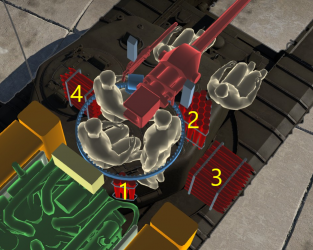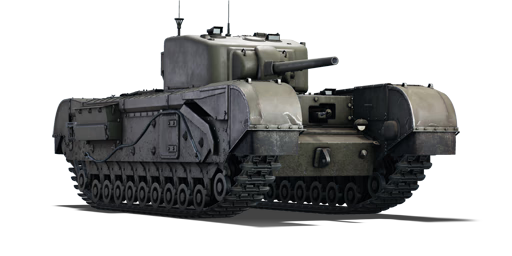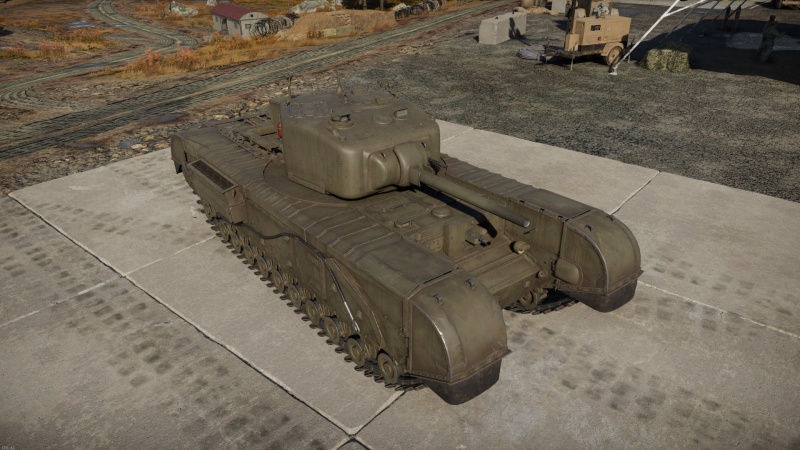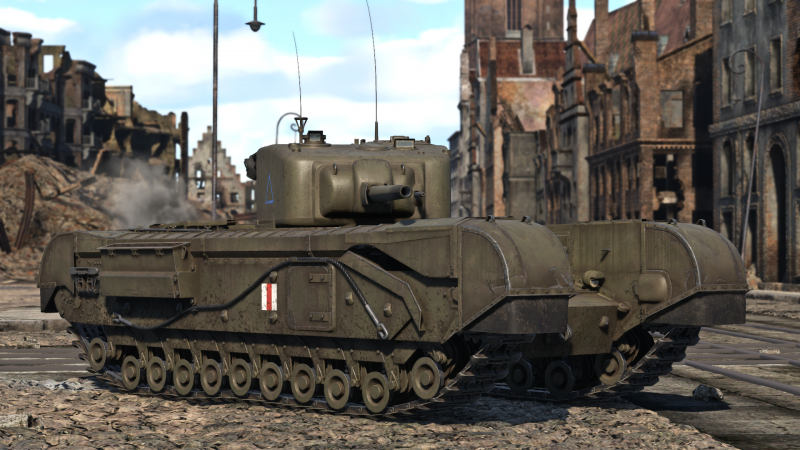Difference between revisions of "Churchill NA75"
(I added the whole history section using 3 main sources.) (Tag: Visual edit) |
(→Description: Updated to new format) |
||
| (11 intermediate revisions by 3 users not shown) | |||
| Line 6: | Line 6: | ||
{{Specs-Card | {{Specs-Card | ||
|code=uk_churchill_na75 | |code=uk_churchill_na75 | ||
| − | |images={{Specs-Card-Image|GarageImage_{{PAGENAME}}.jpg}} | + | |images={{Specs-Card-Image|GarageImage_{{PAGENAME}}.jpg|ArtImage_{{PAGENAME}}.png}} |
}} | }} | ||
== Description == | == Description == | ||
<!-- ''In the description, the first part should be about the history of the creation and combat usage of the vehicle, as well as its key features. In the second part, tell the reader about the ground vehicle in the game. Insert a screenshot of the vehicle, so that if the novice player does not remember the vehicle by name, he will immediately understand what kind of vehicle the article is talking about.'' --> | <!-- ''In the description, the first part should be about the history of the creation and combat usage of the vehicle, as well as its key features. In the second part, tell the reader about the ground vehicle in the game. Insert a screenshot of the vehicle, so that if the novice player does not remember the vehicle by name, he will immediately understand what kind of vehicle the article is talking about.'' --> | ||
| − | The '''{{Specs|name}}''' | + | Following the battle experiences in North Africa, there was a need among Churchill tank crews for a better armament in order to support the infantry. Early Churchill tanks were armed with cannons that had relatively lackluster high-explosive capabilities like the 2-pounder and 6-pounder guns. An enterprising REME (Royal Electric and Mechanical Engineers) Captain, Percy Morrell, recognized that there were many M4 Shermans slated to be scrapped with still functioning 75 mm armament. In a bid to upgrade the Churchill tanks for combat, he suggested and proved the feasibility of taking the M34 gun mantlet and 75 mm M3 cannon off the M4 Sherman tanks and installing them onto the turret face of the Churchill tanks. The modified Churchills, mostly Mark IVs, were given top priority with 200 modified with the M4 Sherman mantlet prior to June 1944. The modified tank was designated "NA75" (for North Africa 75 mm) and was sent to the Italian theater to fight, most notably during the assaults against the Gothic Line. |
| + | |||
| + | Introduced in [[Update "Sky Guardians"]], the '''{{Specs|name}}''' can be seen as a sidegrade grade of the [[Churchill III]], but with a 75 mm gun and a different turret design. This leads to somewhat lower penetration values compared to what the 6-pounder on the Mk III can provide, but the post-penetration damage on the NA75 is much stronger than what the 6-pounder can deliver. Another minor change to the NA75's benefit is stronger turret front armour due to the usage of the M4 Sherman mantlet in the turret front. However, with the same weight and engine as the Mk III, the Churchill NA75's manoeuverability on the battlefield will be very similar, if not exactly identical. | ||
== General info == | == General info == | ||
| Line 17: | Line 19: | ||
{{Specs-Tank-Armour}} | {{Specs-Tank-Armour}} | ||
<!-- ''Describe armour protection. Note the most well protected and key weak areas. Appreciate the layout of modules as well as the number and location of crew members. Is the level of armour protection sufficient, is the placement of modules helpful for survival in combat? If necessary use a visual template to indicate the most secure and weak zones of the armour.'' --> | <!-- ''Describe armour protection. Note the most well protected and key weak areas. Appreciate the layout of modules as well as the number and location of crew members. Is the level of armour protection sufficient, is the placement of modules helpful for survival in combat? If necessary use a visual template to indicate the most secure and weak zones of the armour.'' --> | ||
| + | The Churchill NA75 has the ability to angle the tank to improve overall frontal armour and thus survivability. | ||
'''Armour type:''' | '''Armour type:''' | ||
| Line 28: | Line 31: | ||
|- | |- | ||
| Hull || 89 mm ''Front plate'' <br> 89 + 89 mm ''Front plate (MG Port)'' <br> 38 mm (70°) ''Front glacis'' <br> 76.2 mm (20°) ''Lower glacis'' | | Hull || 89 mm ''Front plate'' <br> 89 + 89 mm ''Front plate (MG Port)'' <br> 38 mm (70°) ''Front glacis'' <br> 76.2 mm (20°) ''Lower glacis'' | ||
| − | | 64 mm <br> 76.2 mm ''Side hatch'' <br> 38 mm ''Edges'' <br> 26 + 38 mm ''Rear'' | + | | 64 mm <br> 76.2 mm ''Side hatch'' <br> 38 mm ''Edges'' <br> 26 + 38 mm ''Rear'' || 50.8 mm <br> 25.4 mm (71°) ''Bottom'' || 15.87 mm |
| − | | 50.8 mm <br> 25.4 mm (71°) ''Bottom'' | ||
| − | | 15.87 mm | ||
|- | |- | ||
| Turret || 89-104 mm (1°-38°) ''Turret front'' <br>76.2 mm (5°-65°) + 50.8 mm (10°-63°) ''Gun mantlet'' || 76-80 mm || 76-80 mm || 35-45 mm | | Turret || 89-104 mm (1°-38°) ''Turret front'' <br>76.2 mm (5°-65°) + 50.8 mm (10°-63°) ''Gun mantlet'' || 76-80 mm || 76-80 mm || 35-45 mm | ||
|- | |- | ||
| − | | Cupola || 19.05 mm || 19.05 mm || 19.05 mm || 19.5 mm ''Front'' | + | | Cupola || 19.05 mm || 19.05 mm || 19.05 mm || 19.5 mm ''Front'' <br> 25.4 mm ''Back'' |
| − | 25.4 mm ''Back'' | ||
|- | |- | ||
|} | |} | ||
| − | |||
'''Notes:''' | '''Notes:''' | ||
| Line 49: | Line 48: | ||
''Write about the mobility of the ground vehicle. Estimate the specific power and manoeuvrability, as well as the maximum speed forwards and backwards.'' | ''Write about the mobility of the ground vehicle. Estimate the specific power and manoeuvrability, as well as the maximum speed forwards and backwards.'' | ||
| − | {{tankMobility}} | + | {{tankMobility|abMinHp=452|rbMinHp=310}} |
=== Modifications and economy === | === Modifications and economy === | ||
| Line 59: | Line 58: | ||
{{Specs-Tank-Weapon|1}} | {{Specs-Tank-Weapon|1}} | ||
<!-- ''Give the reader information about the characteristics of the main gun. Assess its effectiveness in a battle based on the reloading speed, ballistics and the power of shells. Do not forget about the flexibility of the fire, that is how quickly the cannon can be aimed at the target, open fire on it and aim at another enemy. Add a link to the main article on the gun: <code><nowiki>{{main|Name of the weapon}}</nowiki></code>. Describe in general terms the ammunition available for the main gun. Give advice on how to use them and how to fill the ammunition storage.'' --> | <!-- ''Give the reader information about the characteristics of the main gun. Assess its effectiveness in a battle based on the reloading speed, ballistics and the power of shells. Do not forget about the flexibility of the fire, that is how quickly the cannon can be aimed at the target, open fire on it and aim at another enemy. Add a link to the main article on the gun: <code><nowiki>{{main|Name of the weapon}}</nowiki></code>. Describe in general terms the ammunition available for the main gun. Give advice on how to use them and how to fill the ammunition storage.'' --> | ||
| − | {{main| | + | {{main|M3 (75 mm)}} |
{| class="wikitable" style="text-align:center" width="100%" | {| class="wikitable" style="text-align:center" width="100%" | ||
|- | |- | ||
| − | ! colspan="5" | [[ | + | ! colspan="5" | [[M3 (75 mm)|75 mm M3]] || colspan="5" | Turret rotation speed (°/s) || colspan="4" | Reloading rate (seconds) |
|- | |- | ||
! Mode !! Capacity !! Vertical !! Horizontal !! Stabilizer | ! Mode !! Capacity !! Vertical !! Horizontal !! Stabilizer | ||
| Line 98: | Line 97: | ||
* Racks disappear after all shells in the rack have been fired. | * Racks disappear after all shells in the rack have been fired. | ||
| + | {{Clear}} | ||
=== Machine guns === | === Machine guns === | ||
| Line 120: | Line 120: | ||
=== Pros and cons === | === Pros and cons === | ||
<!-- ''Summarise and briefly evaluate the vehicle in terms of its characteristics and combat effectiveness. Mark its pros and cons in a bulleted list. Try not to use more than 6 points for each of the characteristics. Avoid using categorical definitions such as "bad", "good" and the like - use substitutions with softer forms such as "inadequate" and "effective".'' --> | <!-- ''Summarise and briefly evaluate the vehicle in terms of its characteristics and combat effectiveness. Mark its pros and cons in a bulleted list. Try not to use more than 6 points for each of the characteristics. Avoid using categorical definitions such as "bad", "good" and the like - use substitutions with softer forms such as "inadequate" and "effective".'' --> | ||
| − | |||
'''Pros:''' | '''Pros:''' | ||
| − | * | + | * The cheek area of the turret is significantly reduced and well sloped sideways (previously a major weak spot of Churchill III) |
| + | * The 75 mm gun offers a significant improvement in firepower | ||
| + | * The M61 APHE shot makes engaging and destroying enemies much easier than with solid shots | ||
| + | * A great gun depression of -12 degrees makes fighting in mountainous terrain easy | ||
| + | * Excellent armour for its BR range; can withstand multiple enemy shots (except the German long 75 mm guns) | ||
| + | * Has smoke grenades to lay a smoke screen | ||
'''Cons:''' | '''Cons:''' | ||
| − | * | + | * Vehicle difficult to manoeuvre in tight and narrow streets, and with a terrible and slow reverse speed (-3 km/h) |
| + | * Slow top speed and poor mobility are inherent weaknesses, requiring extra caution in close quarters engagement. | ||
| + | * No primitive gun stabiliser for the 75 mm gun, sudden stopping of the tank causes the gun to wobble | ||
== History == | == History == | ||
<!-- ''Describe the history of the creation and combat usage of the vehicle in more detail than in the introduction. If the historical reference turns out to be too long, take it to a separate article, taking a link to the article about the vehicle and adding a block "/History" (example: <nowiki>https://wiki.warthunder.com/(Vehicle-name)/History</nowiki>) and add a link to it here using the <code>main</code> template. Be sure to reference text and sources by using <code><nowiki><ref></ref></nowiki></code>, as well as adding them at the end of the article with <code><nowiki><references /></nowiki></code>. This section may also include the vehicle's dev blog entry (if applicable) and the in-game encyclopedia description (under <code><nowiki>=== In-game description ===</nowiki></code>, also if applicable).'' --> | <!-- ''Describe the history of the creation and combat usage of the vehicle in more detail than in the introduction. If the historical reference turns out to be too long, take it to a separate article, taking a link to the article about the vehicle and adding a block "/History" (example: <nowiki>https://wiki.warthunder.com/(Vehicle-name)/History</nowiki>) and add a link to it here using the <code>main</code> template. Be sure to reference text and sources by using <code><nowiki><ref></ref></nowiki></code>, as well as adding them at the end of the article with <code><nowiki><references /></nowiki></code>. This section may also include the vehicle's dev blog entry (if applicable) and the in-game encyclopedia description (under <code><nowiki>=== In-game description ===</nowiki></code>, also if applicable).'' --> | ||
| − | + | ''Describe the history of the creation and combat usage of the vehicle in more detail than in the introduction. If the historical reference turns out to be too long, take it to a separate article, taking a link to the article about the vehicle and adding a block "/History" (example: <nowiki>https://wiki.warthunder.com/(Vehicle-name)/History</nowiki>) and add a link to it here using the <code>main</code> template. Be sure to reference text and sources by using <code><nowiki><ref></ref></nowiki></code>, as well as adding them at the end of the article with <code><nowiki><references /></nowiki></code>. This section may also include the vehicle's dev blog entry (if applicable) and the in-game encyclopedia description (under <code><nowiki>=== In-game description ===</nowiki></code>, also if applicable).'' | |
| − | |||
| − | |||
| − | |||
| − | |||
| − | |||
| − | |||
| − | |||
| − | |||
| − | |||
| − | |||
| − | |||
| − | |||
| − | |||
| − | |||
| − | |||
| − | |||
| − | |||
| − | |||
| − | === | ||
| − | |||
== Media == | == Media == | ||
<!-- ''Excellent additions to the article would be video guides, screenshots from the game, and photos.'' --> | <!-- ''Excellent additions to the article would be video guides, screenshots from the game, and photos.'' --> | ||
| − | + | ||
| + | ;Skins | ||
| + | * [https://live.warthunder.com/feed/camouflages/?vehicle=uk_churchill_na75 Skins and camouflages for the {{PAGENAME}} from live.warthunder.com.] | ||
== See also == | == See also == | ||
| Line 167: | Line 155: | ||
* [[Churchill III]] | * [[Churchill III]] | ||
* [[Pz.Kpfw. Churchill (Germany)|▀Pz.Kpfw. Churchill]] | * [[Pz.Kpfw. Churchill (Germany)|▀Pz.Kpfw. Churchill]] | ||
| − | |||
| − | |||
== External links == | == External links == | ||
Latest revision as of 05:14, 20 August 2024
| This page is about the British heavy tank Churchill NA75. For other versions, see Churchill (Family). |
Contents
Description
Following the battle experiences in North Africa, there was a need among Churchill tank crews for a better armament in order to support the infantry. Early Churchill tanks were armed with cannons that had relatively lackluster high-explosive capabilities like the 2-pounder and 6-pounder guns. An enterprising REME (Royal Electric and Mechanical Engineers) Captain, Percy Morrell, recognized that there were many M4 Shermans slated to be scrapped with still functioning 75 mm armament. In a bid to upgrade the Churchill tanks for combat, he suggested and proved the feasibility of taking the M34 gun mantlet and 75 mm M3 cannon off the M4 Sherman tanks and installing them onto the turret face of the Churchill tanks. The modified Churchills, mostly Mark IVs, were given top priority with 200 modified with the M4 Sherman mantlet prior to June 1944. The modified tank was designated "NA75" (for North Africa 75 mm) and was sent to the Italian theater to fight, most notably during the assaults against the Gothic Line.
Introduced in Update "Sky Guardians", the Tank, Infantry, Mk IV, Churchill NA75 can be seen as a sidegrade grade of the Churchill III, but with a 75 mm gun and a different turret design. This leads to somewhat lower penetration values compared to what the 6-pounder on the Mk III can provide, but the post-penetration damage on the NA75 is much stronger than what the 6-pounder can deliver. Another minor change to the NA75's benefit is stronger turret front armour due to the usage of the M4 Sherman mantlet in the turret front. However, with the same weight and engine as the Mk III, the Churchill NA75's manoeuverability on the battlefield will be very similar, if not exactly identical.
General info
Survivability and armour
The Churchill NA75 has the ability to angle the tank to improve overall frontal armour and thus survivability.
Armour type:
- Rolled homogeneous armour (Hull, Cupola doors)
- Cast homogeneous armour (Turret, Hull machine gun area)
| Armour | Front (Slope angle) | Sides | Rear | Roof |
|---|---|---|---|---|
| Hull | 89 mm Front plate 89 + 89 mm Front plate (MG Port) 38 mm (70°) Front glacis 76.2 mm (20°) Lower glacis |
64 mm 76.2 mm Side hatch 38 mm Edges 26 + 38 mm Rear |
50.8 mm 25.4 mm (71°) Bottom |
15.87 mm |
| Turret | 89-104 mm (1°-38°) Turret front 76.2 mm (5°-65°) + 50.8 mm (10°-63°) Gun mantlet |
76-80 mm | 76-80 mm | 35-45 mm |
| Cupola | 19.05 mm | 19.05 mm | 19.05 mm | 19.5 mm Front 25.4 mm Back |
Notes:
- Suspension wheels and chassis construction are 20 mm thick while tracks are 30 mm thick.
- Air inlets have a 63.5 mm plate modelled.
Mobility
Write about the mobility of the ground vehicle. Estimate the specific power and manoeuvrability, as well as the maximum speed forwards and backwards.
| Game Mode | Max Speed (km/h) | Weight (tons) | Engine power (horsepower) | Power-to-weight ratio (hp/ton) | |||
|---|---|---|---|---|---|---|---|
| Forward | Reverse | Stock | Upgraded | Stock | Upgraded | ||
| Arcade | Expression error: Unexpected * operator. | 452 | Expression error: Unexpected round operator. | __.__ | |||
| Realistic | 310 | Expression error: Unexpected round operator. | __.__ | ||||
Modifications and economy
Armaments
Main armament
| 75 mm M3 | Turret rotation speed (°/s) | Reloading rate (seconds) | |||||||||||
|---|---|---|---|---|---|---|---|---|---|---|---|---|---|
| Mode | Capacity | Vertical | Horizontal | Stabilizer | Stock | Upgraded | Full | Expert | Aced | Stock | Full | Expert | Aced |
| Arcade | 81 | -12°/+20° | ±180° | - | 19.4 | 26.9 | 32.6 | 36.1 | 38.4 | 6.50 | 5.75 | 5.30 | 5.00 |
| Realistic | 14.3 | 16.8 | 20.4 | 22.6 | 24.0 | ||||||||
Ammunition
| Penetration statistics | |||||||
|---|---|---|---|---|---|---|---|
| Ammunition | Type of warhead |
Penetration @ 0° Angle of Attack (mm) | |||||
| 10 m | 100 m | 500 m | 1,000 m | 1,500 m | 2,000 m | ||
| M72 shot | AP | 91 | 88 | 78 | 67 | 57 | 49 |
| M61 shot | APCBC | 104 | 101 | 90 | 78 | 68 | 59 |
| M48 shell | HE | 10 | 10 | 10 | 10 | 10 | 10 |
| Shell details | ||||||||||||
|---|---|---|---|---|---|---|---|---|---|---|---|---|
| Ammunition | Type of warhead |
Velocity (m/s) |
Projectile mass (kg) |
Fuse delay (m) |
Fuse sensitivity (mm) |
Explosive mass (TNT equivalent) (g) |
Ricochet | |||||
| 0% | 50% | 100% | ||||||||||
| M72 shot | AP | 619 | 6.3 | - | - | - | 47° | 60° | 65° | |||
| M61 shot | APCBC | 618 | 6.79 | 1.2 | 14 | 63.7 | 48° | 63° | 71° | |||
| M48 shell | HE | 463 | 6.3 | 0 | 0.1 | 666 | 79° | 80° | 81° | |||
| Smoke shell characteristics | ||||||
|---|---|---|---|---|---|---|
| Ammunition | Velocity (m/s) |
Projectile mass (kg) |
Screen radius (m) |
Screen deploy time (s) |
Screen hold time (s) |
Explosive mass (TNT equivalent) (g) |
| M89 | 259 | 3 | 13 | 5 | 20 | 50 |
Ammo racks

| Full ammo |
1st rack empty |
2nd rack empty |
3rd rack empty |
4th rack empty |
Visual discrepancy |
|---|---|---|---|---|---|
| 81 | 78 (+3) | 57 (+24) | 18 (+63) | 1 (+80) | No |
Notes:
- Racks disappear after all shells in the rack have been fired.
Machine guns
| 7.92 mm BESA | ||||
|---|---|---|---|---|
| Mount | Capacity (Belt) | Fire rate | Vertical | Horizontal |
| Coaxial | 9,450 (225) | 600 | - | - |
Usage in battles
Describe the tactics of playing in the vehicle, the features of using vehicles in the team and advice on tactics. Refrain from creating a "guide" - do not impose a single point of view but instead give the reader food for thought. Describe the most dangerous enemies and give recommendations on fighting them. If necessary, note the specifics of the game in different modes (AB, RB, SB).
Pros and cons
Pros:
- The cheek area of the turret is significantly reduced and well sloped sideways (previously a major weak spot of Churchill III)
- The 75 mm gun offers a significant improvement in firepower
- The M61 APHE shot makes engaging and destroying enemies much easier than with solid shots
- A great gun depression of -12 degrees makes fighting in mountainous terrain easy
- Excellent armour for its BR range; can withstand multiple enemy shots (except the German long 75 mm guns)
- Has smoke grenades to lay a smoke screen
Cons:
- Vehicle difficult to manoeuvre in tight and narrow streets, and with a terrible and slow reverse speed (-3 km/h)
- Slow top speed and poor mobility are inherent weaknesses, requiring extra caution in close quarters engagement.
- No primitive gun stabiliser for the 75 mm gun, sudden stopping of the tank causes the gun to wobble
History
Describe the history of the creation and combat usage of the vehicle in more detail than in the introduction. If the historical reference turns out to be too long, take it to a separate article, taking a link to the article about the vehicle and adding a block "/History" (example: https://wiki.warthunder.com/(Vehicle-name)/History) and add a link to it here using the main template. Be sure to reference text and sources by using <ref></ref>, as well as adding them at the end of the article with <references />. This section may also include the vehicle's dev blog entry (if applicable) and the in-game encyclopedia description (under === In-game description ===, also if applicable).
Media
- Skins
See also
Similar Churchill variants in the game:
External links
Paste links to sources and external resources, such as:
- topic on the official game forum;
- other literature.
| Britain heavy tanks | |
|---|---|
| Matilda | Matilda III · Matilda Hedgehog |
| Churchill | Churchill I · Churchill III · Churchill VII · Churchill Crocodile · Churchill NA75 · Black Prince |
| Post-war | Caernarvon · Conqueror |
| Other | Independent · Excelsior · TOG II |






